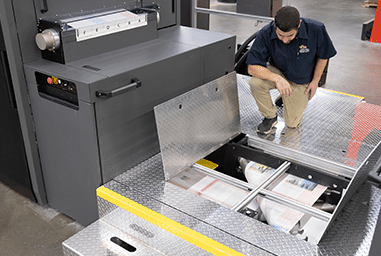Inkjet printing is seen as the primary driver for the printing industry’s transition from traditional printing processes to digital printing and is becoming increasingly established as a production printing process. Whether the expectations of printers, their customers are met and a print job is profitable also depends on the visual appearance and durability of the inks on the substrates.
With market-proven expertise in the development of printing technologies and consumables for inkjet production printing, Kodak takes a flexible approach to inks. The company’s strategy is to offer a specific ink set and pre-treat the surfaces of different substrates with ink-friendly primers, the KODAK OPTIMAX Primers. “Our unique, simple ink and primer strategy enables users of KODAK PROSPER technology solutions in various segments of the commercial and packaging printing industry to achieve vibrant, accurate and consistent colour on virtually any substrate,” says Jim Continenza, Executive Chairman and CEO of Kodak.
KODACHROME and KODAK EKTACOLOR inks
In the field of advanced materials and chemicals as well as colour science and management, Kodak develops and produces high-performance inks that are suitable for a wide range of processes and applications. A key advantage of the inks is Kodak’s pigment micromilling process. A process that produces very fine nanoparticle pigments that have a narrow size distribution. The finer pigments ensure that inks are easier to print, reduce light scattering so that an above-average colour gamut can be reproduced and ultra-thin dried ink layers are created. “With these capabilities, our KODACHROME inks help make the PROSPER ULTRA 520 press – in addition to its productivity and economy – a true replacement for traditional offset printing in terms of quality,” comments Jim Continenza. A common feature of KODACHROME and EKTACOLOR inks is their low humectant content, which can lead to faster drying when printing difficult materials with high ink coverage.
First-class and durable prints
In addition to creating an adhesive layer for the ink on the substrate, OPTIMAX primers also immobilise the pigment, which enables wet-on-wet printing with high ink coverage at high speeds. When printing on absorbent substrates, OPTIMAX primers hold the ink, especially the nanoparticle colour pigments, on the surface while the carrier liquid penetrates the material. On non-absorbent substrates, the primer creates an adhesive surface that holds the ink droplets in place, preventing them from flowing out or running into each other. Kodak offers a range of OPTIMAX high performance primers designed for a wide range of substrates and applications. These include an OPTIMAX Standard Primer for uncoated papers and an OPTIMAX Enhanced Primer for coated papers. OPTIMAX Packaging Primers are available for packaging applications with coated and uncoated folding boxboard and corrugated board as well as for non-absorbent substrates such as plastics, films and materials for personal hygiene products.
Sustainability
OPTIMAX primers are also sustainably based on water. Furthermore, both primers and inks contain no volatile organic compounds (VOCs), which also benefits sustainability and improves the working environment for press operators. In addition, Kodak’s inks are toy-safe, making them a safe solution for children’s books and are also suitable for indirect food contact in packaging applications.
Complete solutions for profitable printing
Together with Kodak’s high-speed continuous inkjet technologies, KODACHROME and EKTACOLOR inks and OPTIMAX primers form a complete inkjet ecosystem with coordinated components. “Our customers can rely on a single supplier for all their digital printing needs and be confident that KODAK inks and primers have been optimised specifically for KODAK PROSPER products. All of this enhances print quality and operational effectiveness for printers and helps them produce a growing number of applications efficiently, productively and profitably with our leading inkjet production printing solutions,” concludes Jim Continenza.
Kodak
The US company can look back on a long tradition in printing and publishing. The company first sold materials for the printing industry as early as 1912 and in 1929 launched high-contrast KODALITH materials on the market, which made it easier to prepare halftones for printing. In the mid-1930s, Kodak researchers developed and built the world’s first electronic colour separation scanner to prepare images for printing. When electronics entered the typesetting industry in the 1960s, Kodak supplied many new generations of films and printing plates for the graphic arts industry. Kodak also introduced the first digital halftone colour proofing system, the KODAK APPROVAL system, which made it possible to see the quality of the final output without making a proof. Today, KODAK is a global technology company focused on printing and advanced materials & chemicals. KODAK provides industry-leading hardware, software, consumables and services to customers in the commercial, packaging, publishing, manufacturing and entertainment printing industries.

